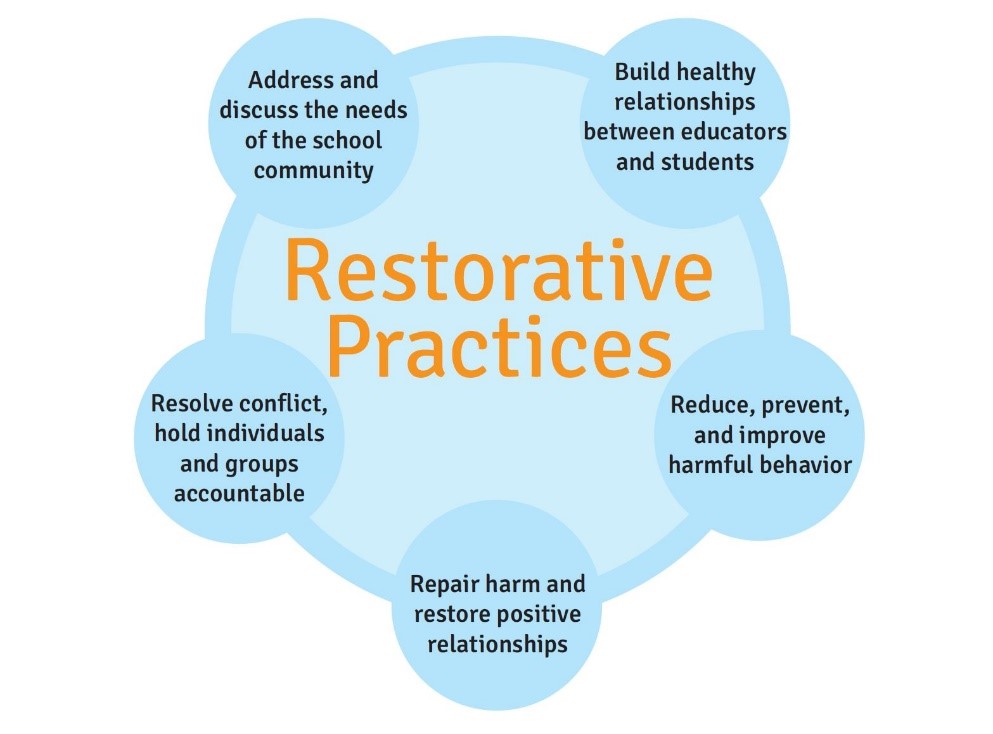What is restorative practice?
Restorative practice is a whole school teaching and learning approach that encourages behaviour that is supportive and respectful. It puts the onus on individuals to be truly accountable for their behaviour and to repair any harm caused to others as a result of their actions.

A restorative approach focuses on building, maintaining and restoring positive relationships, particularly when incidents that involve interpersonal conflict or wrongdoing occur.
When executive staff prioritise a restorative approach to relationships across the school community and provide adequate staff training and support for implementation, schools can reduce the frequency of behaviour incidents and improve school culture. Restorative practices work best when the whole school community is on board. There are many examples in literature of schools reducing suspension rates and improving student behaviour by adopting this approach.
Types of restorative practices
Staff, students and parents often interact at the school gate, in the playground, on excursions, at the canteen, on the sports field and other places around the school. Restorative practices can be used in all these places to create and maintain a safe and supportive environment where healthy relationships are nurtured.
Think about the following:
- If someone came into your school for the first time, how would they describe it?
- What can you do to make students, other staff and parents feel welcome and valued?
- How can you ensure your school is a safe space for students, staff and parents?
- Do students, staff and parents actively participate in school activities?
- How do staff teach pro-social behaviour and build positive relationships between students, staff and parents at your school?
- What is your school’s process for preventing and addressing conflict or disagreement?
- How are students and staff involved in this process?
Teachers have an opportunity to model restorative strategies for students in the classroom. Have a think about your own classroom practices.
Think about the following:
- What do you do to actively ensure students in your class feel welcome and that they belong?
- How does your classroom environment impact how students communicate with each other and with you?
- How do you interact with the students in your class and how do you interact with colleagues?
- How do you respond when you have a conflict with one of your students?
- How do you respond when you see a conflict arising between students in the classroom?
- What process do you use to resolve conflict or disagreement in your classroom?
- How were students involved in the development of this process?
Implementing restorative practices
Informal restorative practices are simple, low-key ways educators and other school staff can influence a positive environment. This can include strategies such as using ‘I’ statements to communicate feelings and putting the focus on how one person or one group can be impacted by the behaviour of others. The focus is on the behaviour, not the person.
Affective questions can also be used to encourage the person who caused the harm to stop and reflect on who was affected and how they were affected.
Other informal practices include proactive engagement with students and families, mentoring relationships, community service, and lunchtime table talks.
This approach is sometimes called ‘circle time’, where the whole group or class form a circle to interact. This promotes inclusiveness and provides opportunities for everyone to speak and listen to one another in a safe environment. Circles can be used for:
- celebrating student successes
- beginning and ending the day
- discussing difficult issues.
By going around the circle in order, everyone has an opportunity to be heard. This process also reduces the risk of discussions being dominated by a small number of people. A talking piece such as a ball or soft toy can be introduced to facilitate taking turns to speak in the circle.
Key elements of talking piece etiquette include:
- ensuring circle members only talk when they have the talking piece
- encouraging circle members to speak honestly and with respect for others
- ensuring circle members only talk about relevant issues and don’t speak for too long
- allowing circle members to pass the talking piece on if they don’t want to speak
- ensuring the talking piece moves in one direction around the circle, unless otherwise decided by the group.
Circles can be used to teach pro-social skills and build relationships by playing getting to know you type games and activities. For more ideas, visit the resources for educations section of the NSW anti-bullying website.
Social-emotional learning can help students and adults to calm themselves when they feel angry, make friends, resolve conflicts respectfully and make safe choices. Specific SEL skills include:
- recognising and managing emotions
- developing caring and concern for others
- establishing positive relationships
- making responsible decisions
- handling challenging situations.
To learn more visit social-emotional learning.
Conflict resolution programs help students by teaching them how to manage conflict, defuse situations, repair hurt feelings and reduce the likelihood of retaliation after a conflict. To learn more visit conflict resolution.
Peer mediation invites students to take responsibility for their actions by working together to find solutions to any conflict. Two trained students (mediators) lead disputants through a structured process.
Peer mediation aims to:
- increase awareness of how conflict can affect peoples' lives and relationships
- improve communication between students and between teachers and students
- teach students skills such as listening, critical-thinking and problem-solving
- empower students by having them take greater responsibility for resolving their disputes.
While peer mediation has been shown to reduce disciplinary issues, it is important to ensure that conflict resolution does not become the task of students alone.
To learn more visit peer mediation.
Individuals can attempt to repair a harm that has impacted the school community by taking part in a service or project that benefits the community.
To provide feedback on this resource, please complete the Feedback form.